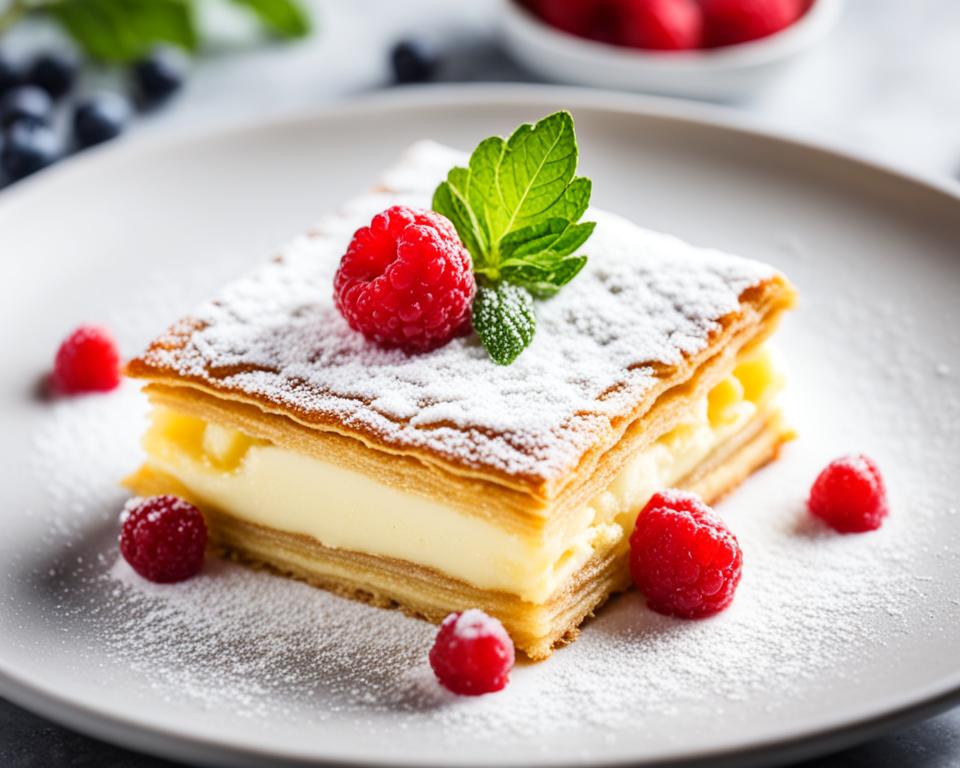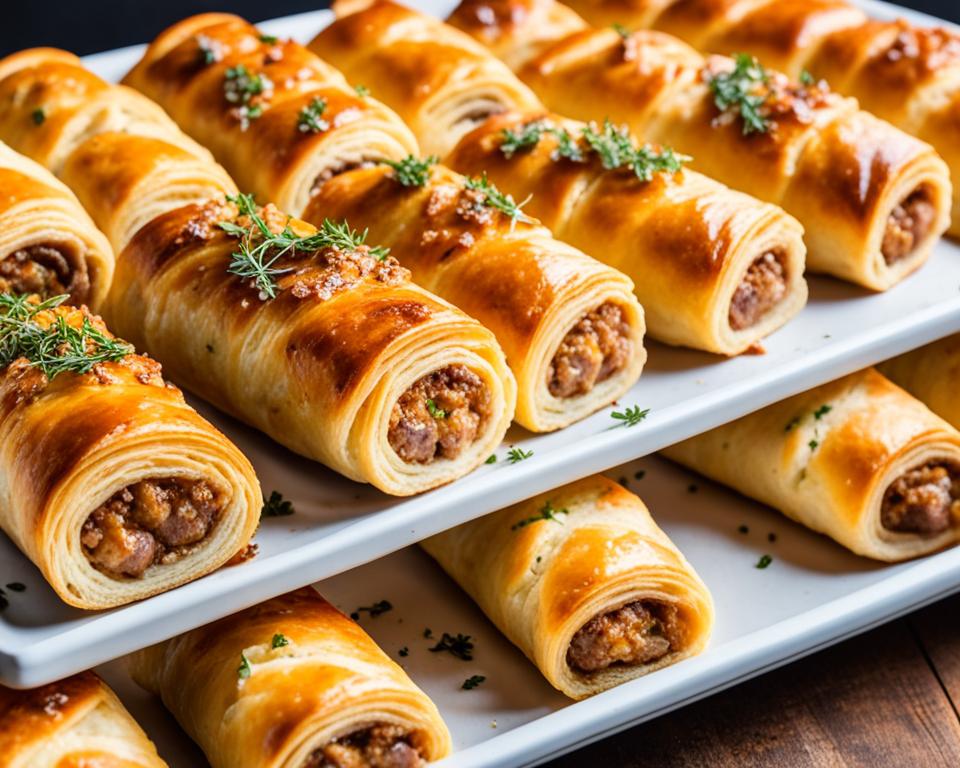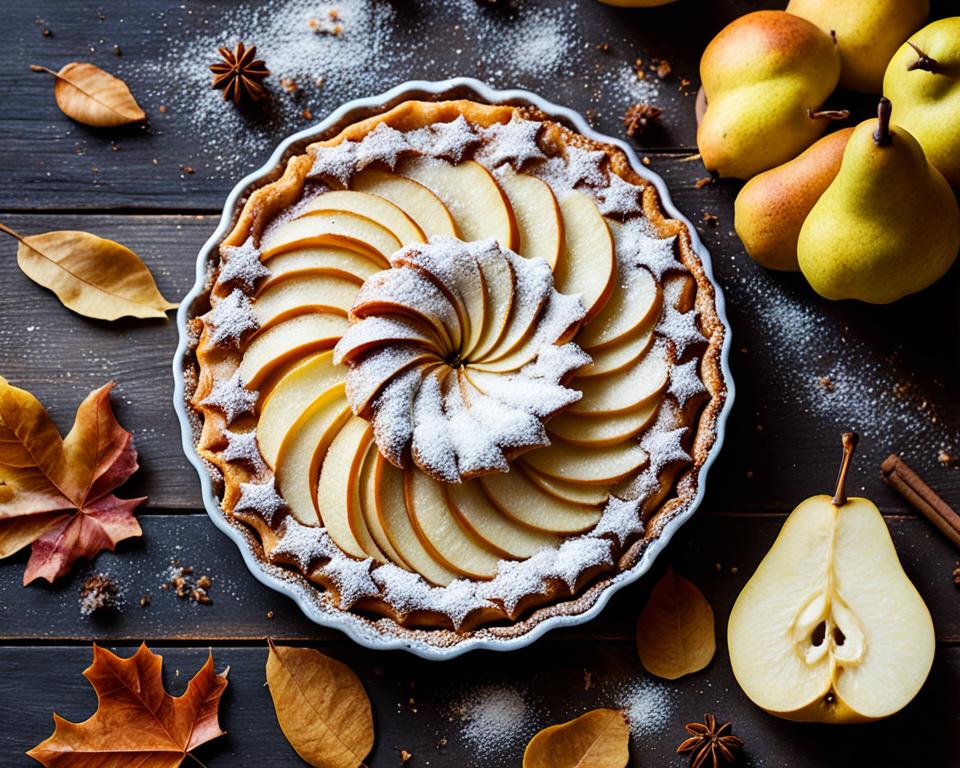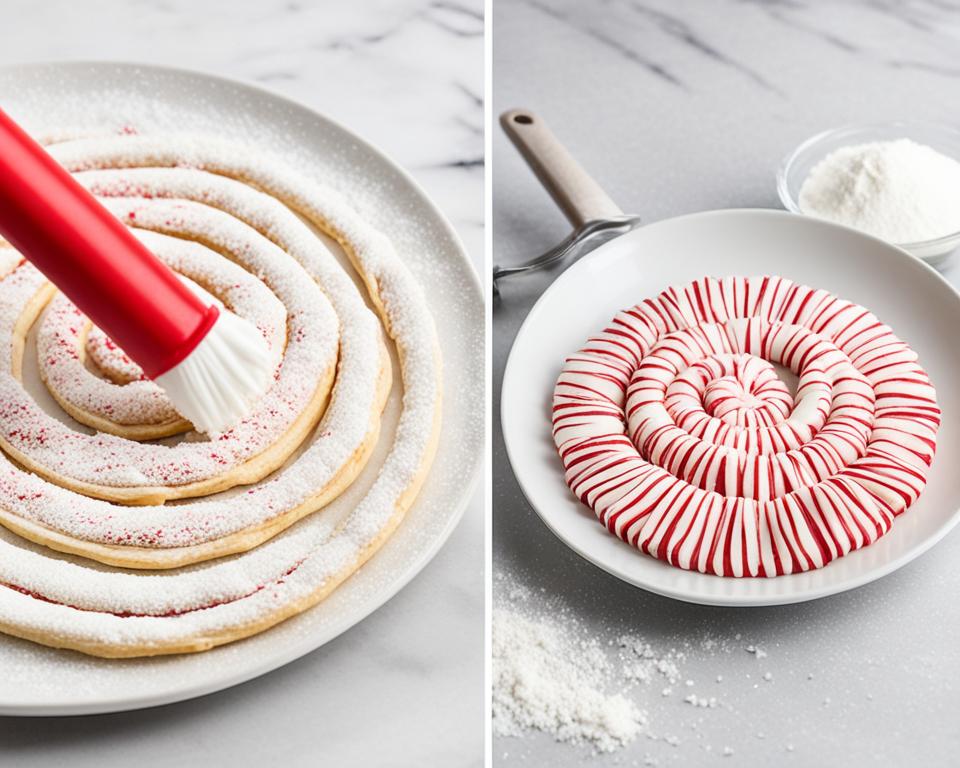The allure of a fresh flaky Napoleon often resides in its tantalizing layers, the buttery crispness of the puff pastry dessert yielding to the sumptuousness of a well-crafted filling. For many dessert connoisseurs, the Napoleon is not just a treat; it is a cornerstone of patisserie, a symbol of finesse and indulgence. The secret to this delicious pastry lies not just in the adherence to a time-honored dessert recipe, but also in the love and care infused in each step—from the selection of premium ingredients to the gentle assembly of its delicate layers.
While historical ties to Napoleon Bonaparte himself may remain a subject of friendly dispute among culinary historians, there’s no debating the enduring legacy of this beloved dessert. With its roots firmly grounded in French culinary tradition, the Napoleon continues to enchant with each flaky, cream-laden bite. For those embarking on the rewarding journey of creating this storied sweet at home, the path to success includes choosing quality puff pastry and infusing the cream with the pure essence of vanilla. Modern conveniences, like the availability of store-bought puff pastry, have made it easier for today’s home bakers to bring this elegant dessert to life.
Key Takeaways
- The Napoleon pastry’s distinguished taste is achieved through layered, flaky textures.
- High-quality, store-bought puff pastry makes the dessert more accessible to home chefs.
- Authentic vanilla bean not only adds flavor but also visually enhances the pastry cream.
- A balance between tradition and convenience characterizes modern Napoleon pastry preparations.
- While steeped in heritage, the flaky Napoleon remains amenable to personalized twists in the recipe.
The Allure of Flaky Napoleon: A Delightful French Dessert
The Flaky Napoleon, a treasured classic dessert, captivates the senses with its sumptuous flaky layers and rich history deeply entwined with French dessert traditions. Its enchantment lies in the perfect marriage of texture and flavor that continues to delight pastry enthusiasts worldwide.
Historical Significance of Napoleon Pastry
Divine in every crumb, the Napoleon pastry or mille-feuille stands as a pillar of fine French dessert stratagem. While this pastry’s inception may be shrouded in mystery, its storied past weaves through the annals of French baking, where its layered elegance was fit for an emperor. Certainly more than a mere confectioner’s delight, the Napoleon is a storied testament to the sophistication of French patisserie.
Exploring the Layers of Flavors and Textures
Every slice of Napoleon pastry embodies a symphony of sensations: the audible crunch of its caramelized top layer, the velvet touch of creamy custard nestled between flaky layers, and the sweet, nuanced flavors that dance upon the tongue. Each layer, diligently constructed, delivers a harmonious blend of textures that make the Napoleon pastry as intricate as it is craved, sustaining its renown as a classic dessert that charms with both its form and its substance.
Choosing the Right Ingredients for the Perfect Puff Treat
The quest for the ultimate Napoleon pastry begins with the meticulous selection of ingredients. A flaky pastry, the crowning glory of any puff pastry dessert, demands excellence at each stage of its creation. It’s the interplay between quality and taste that transforms a simple indulgence into a culinary masterpiece. Below, we delve into the key ingredients that set the stage for the most luscious Napoleon pastry.
A superlative Napoleon is built on the foundation of its iconic puff pastry. The choice between homemade or store-bought puff pastry is crucial—each bites into the question of tradition versus convenience. While the technique-driven process of making puff pastry from scratch can be deeply satisfying for some, others may opt for high-quality, pre-made dough for its time-saving grace. Either way, the pastry must embody buttery layers that crisp to perfection in the oven.
When it comes to the luxurious filling that nestles between the pastry layers, the vanilla bean is non-negotiable. A true Napoleon connoisseur can discern the difference made by those tiny, aromatic specks imparted by a real vanilla bean. This authentic touch adds depth to the pastry cream, marrying well with the high-fat contents of whole milk and heavy cream. The right dairy can elevate the pastry cream from simply being a filling to being an opulent, creamy heart of the Napoleon.
Unsalted butter is the silent hero that rounds off the pastry cream, adding a glossy, velvety finish that stands up to the crispness of the surrounding pastry. The table below showcases the indispensable ingredients that, when chosen wisely, will help you create a puff pastry dessert that’s as unforgettable as it is delicious.
| Ingredient | Role | Quality Indicator |
|---|---|---|
| Puff Pastry | Base for layers | Buttery, flaky texture |
| Whole Milk & Heavy Cream | Richness for pastry cream | High fat content, fresh |
| Vanilla Bean | Flavor & aroma | Visibly oily with abundant seeds |
| Unsalted Butter | Glossy finish to pastry cream | Creamy, melts smoothly |
All said, the art of the perfect flaky pastry rests not only on technique but also on the inherent qualities of its components. Each choice is a building block towards achieving the luxurious texture and rich flavor profile that makes a Napoleon pastry a beloved puff pastry dessert.
Gathering Your Baking Tools
Embarking on the creation of a delicious pastry like the classic Napoleon pastry requires not just a top-notch dessert recipe but also the proper baking arsenal. Having the right tools at the ready influences the ease and success of your pastry endeavors. It’s almost as if each rolling pin, measuring spoon, and baking sheet is your sous-chef in disguise, ready to embark with you on this tasty journey.
The Essentials: Rolling Pin and Measuring Tools
Beginning with a trusty rolling pin, a key ally in achieving those perfectly thin and even layers of puff pastry, one can ensure consistency—vital for that signature flakiness. Paired with the preciseness of measuring tools, from cups to spoons to scales, accuracy is maintained, and the guesswork is effectively eliminated. These instruments form the backbone of the process, and their quality can often influence the final outcome of your dessert masterpiece.
Baking Sheets & Parchment Paper: Key to Flaky Layers
The importance of baking sheets and parchment paper cannot be overstated when seeking the golden, flaky layers that Napoleon pastry is renowned for. Acting as the stage on which your pastry performs, these sheets, when layered with parchment, provide a non-stick surface and even heat distribution, resulting in that desirable crispness with every bite. Ensuring you have these components on hand is tantamount to prepping the stage for a standing ovation in your kitchen arena.
Preparing the Vanilla Bean Pastry Cream Filling
The core element that elevates the Napoleon pastry to its iconic status is the vanilla bean pastry cream—a hallmark of the French dessert. To achieve an unmistakable layer of luxury within this delicious pastry, a genuine vanilla bean is essential. It’s through this infusion of real vanilla that authenticity in both taste and aroma is secured, promising every forkful to resonate with the essence of French patisserie excellence.
Infusing Real Vanilla Flavor
The journey to an authentically flavored vanilla bean pastry cream begins with the infusion process. A vanilla bean is split and its seeds are scraped; these precious specks carry concentrated flavor that far surpasses that of extracts. The bean and seeds are then simmered gently with milk, marrying the rich creaminess of dairy with the deep, complex notes of vanilla. This step is about patience and precision, ensuring the flavors have enough time to meld together, setting the stage for a eulogized French dessert experience.
Attaining the Ideal Consistency
Consistency is another crucial aspect of crafting the perfect filling for a Napoleon pastry. The goal is a cream that is luscious and spreadable—neither overly stiff nor too fluid. Mastery in tempering the egg yolk mixture with the hot milk is the secret to achieving this delicate balance. Continuous stirring while cooking prevents the formation of lumps, leading to a creamy and smooth texture that pairs exquisitely with crisp, buttery puff pastry layers. Once cooled, it is not just a filling but the soul of the Napoleon, completing the sensory delight that a slice of this delicious pastry provides.
True to the heritage of French patisserie, the vanilla bean pastry cream is a testimony to the meticulous craftsmanship involved in creating a timeless dessert. Its importance in the Napoleon pastry cannot be overstated; it is the creamy heart in a paradise of flaky layers—a reward for those who appreciate the finery of a decadent yet elegant delight.
Assembling the Flaky Pastry Layers for Your Napoleon
The creation of a flaky Napoleon is akin to the artistry of a painter who meticulously blends colors to achieve the perfect hue. In this case, the palette consists of golden, buttery puff pastry and the silken creaminess of vanilla bean pastry cream. The sublime texture and nuanced flavor of this delicious pastry are a result of precise assembly, demanding both patience and precision.
To commence the assembly, begin with a thawed sheet of puff pastry. Employing a rolling pin and a ruler, meticulously roll out the pastry to ensure uniform thickness—a crucial factor that contributes to the even baking and flakiness of each layer. Measuring is essential: too thin and the pastry may become too brittle; too thick and it may not achieve the desired crispness.
Once rolled to perfection, carefully slice the pastry into evenly shaped rectangles. These will form the structural basis of your Napoleon. Baking is the next transformative step: the pastry sheets should emerge from the oven in a state of golden flakiness, a testament to your baking prowess. Small holes pricked into the surface pre-bake ensure no area puffs more than its counterparts—a trick for maintaining flat yet flaky layers.
The art of layering begins post-baking. The glorious vanilla bean pastry cream you’ve prepared is to be spread generously but thoughtfully between the layers. Each swath of cream should be even, ensuring that every bite a diner takes includes the harmonious combination of crisp pastry and velvety cream. Achieving symmetry in spreading the pastry cream is crucial—it should reach the edges but not spill over, maintaining the Napoleon’s neat presentation.
- Roll thawed puff pastry to an even thickness, approximately 1/4 inch.
- Cut the pastry into rectangles of uniform size for consistent layering.
- Bake the pastry rectangles until they achieve a golden color and flaky texture.
- Allow the baked pastry sheets to cool completely, ensuring they remain crisp.
- Spread a layer of vanilla bean pastry cream on one pastry sheet, followed by another sheet, repeating the process.
The finished dessert recipe is a magnificent stack of textures—crisp pastry yielding to creamy filling—that beckons to be enjoyed. The final Napoleon is a masterpiece of balance and beauty, with alternating layers standing proudly as the embodiment of classic French patisserie. It’s a dessert that promises not just taste, but an experience—a jubilant celebration of the art of baking.
Mastering the Art of Flaky Napoleon
To construct a flaky Napoleon that rivals any French dessert, mastering the manipulation of puff pastry is essential. It is the meticulous attention to detail in handling this delicate medium that yields delectable flaky layers, making each bite of your puff pastry dessert a textural delight.
Rolling and Folding: Secrets to Flaky Layers
The journey to perfect flaky pastry lies in the classical technique of rolling and folding. Start with a well-chilled dough that includes quality butter evenly distributed throughout. This ensures distinct layers that puff apart during the baking process to deliver irresistible flaky layers. The technique involves rolling out the dough, folding it in on itself, and letting it rest. Repeat this process multiple times, and with each fold, you’re crafting the future flaky strata of your Napoleon.
Baking Instructions: Achieving Golden Perfection
Baking is perhaps where the magic truly happens for the transformation of dough into flaky wonder. Begin by preheating your oven to the proper temperature, as a consistent heat is pivotal for puff pastry to rise and color beautifully. Lay your pastry strips on a parchment paper-lined baking sheet, pricking them with a fork to avoid excessive puffing. To ensure perfectly even flaky layers, use another baking sheet to compress the pastry lightly during baking. Time and temperature work in concert to create the quintessential golden hue and crisp texture of a sublime puff pastry dessert. Follow these steps, and a magnificently flaky Napoleon is within reach—each piece a golden, airy testament to your baking prowess.
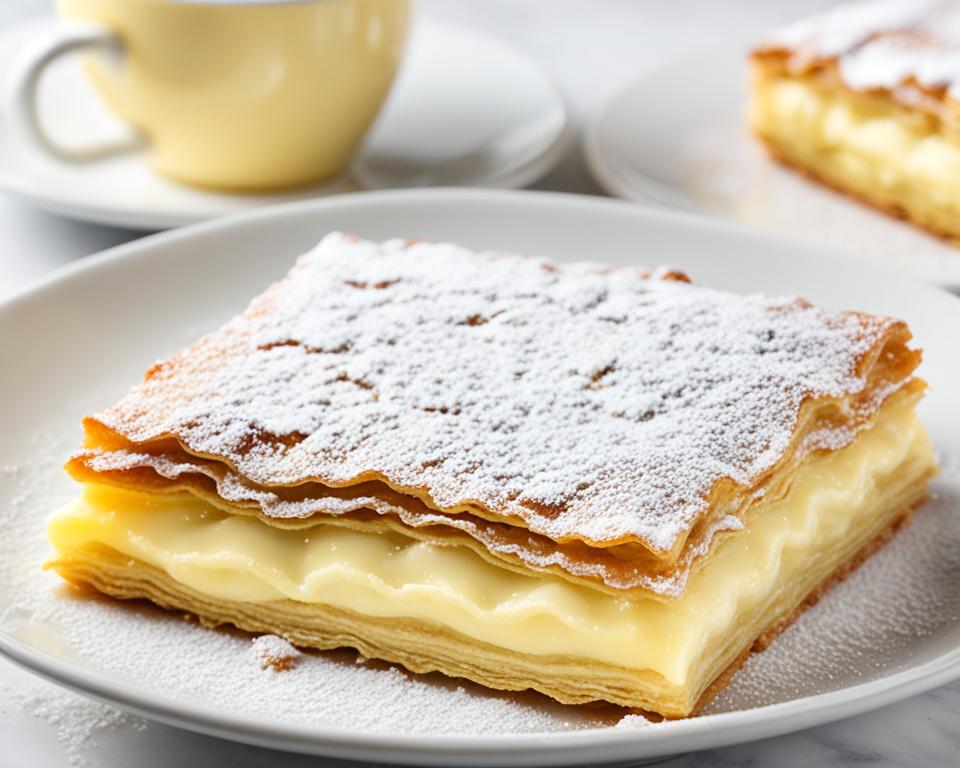
Creating the Feathered Icing Effect
Every baker aspires to perfect the visually stunning feathered icing that often graces the top layer of a flaky Napoleon. This detailed accent not only adds elegance to your Napoleon pastry but it also contributes to the allure of this classic dessert. The process is precise, yet surprisingly simple, and enriches the overall appeal of your pastry masterpiece.
The creation of the feathered effect begins with the application of a smooth layer of white vanilla icing over the pastry. Next, you will drizzle fine lines of rich chocolate glaze across this base. The true artistry of this technique becomes apparent in the next step. Drawing a toothpick perpendicularly through the lines of icing creates the classic feathered design. The contrasting colors and textures between the white and chocolate icings provide not only depth but an invitation to the senses.
While the aesthetics of your Napoleon are essential, taste remains paramount. Ensuring that both the vanilla and chocolate icings are of the highest quality will complement the puff pastry’s buttery layers and the silken pastry cream nestled within. Whether serving this dessert at an elegant dinner or as a sumptuous treat, the feathered icing effect is sure to captivate and impress guests with its refined appearance and exquisite flavor profile.
Below is a step-by-step guide to achieving this coveted decoration:
- Evenly spread a layer of white vanilla icing over the final pastry sheet of your Napoleon.
- Drizzle parallel lines of chocolate icing over the white layer, spaced evenly.
- Using a clean toothpick, gently drag through the chocolate stripes—one line upwards, the next downwards—to create the feathered pattern.
- Allow the icing to set slightly before serving to ensure the design retains its beauty upon slicing.
The completion of this ornamental technique will not only enhance the visual delight but also solidify your status as an artisan of the timeless flaky Napoleon. The interplay of crispy puff pastry and creamy filling, crowned by the intricacy of feathered icing, results in a dessert that truly celebrates the art of French patisserie in every bite.
Classic vs. Modern Takes on Napoleon Pastry
The evolution of the flaky Napoleon has been marked by not only its celebrated past but also its vibrant, innovative present. From its roots as a quintessential French dessert, the modern culinary world has embraced new interpretations of this much-loved dessert recipe. Chefs and bakers have been reimagining the traditional composition of this classic, presenting an exciting array of flavors and textures that appeal to contemporary palates.
Adapting the Filling: Sweet and Savory Variations
While purists may hold dear the original vanilla bean cream that characterizes the classic Napoleon, adventurous bakers now play with a gamut of fillings that range from the indulgently sweet to the unexpectedly savory. Chocolate ganache, citrus-infused creams, and even fruit-laden jams have taken their place within the crisp layers of flaky pastry, offering a refreshing twist on the conventional. For those with a penchant for savory surprises, fillings featuring herbed cheese or roasted vegetables offer a delectable divergence from tradition.
Topping Possibilities: Beyond the Traditional Glaze
The Napoleon’s topmost layer no longer merely suggests the familiar contrast of vanilla and chocolate glazes, though it remains a beloved option. Today’s Napoleon might show a simpler adornment of powdered sugar or cocoa, or it could wear a more lavish accessory of crushed nuts, dollops of caramel, and even fresh berries. Each option not only lends an additional dimension of flavor but also affords each pastry the potential to become a signature offering unique to its maker.
Consider the following table to explore some of the sundry fillings and toppings that have become part of the Flaky Napoleon’s modern recipe repertoire:
| Filling Type | Flavor Profile | Suggested Toppings |
|---|---|---|
| Chocolate Ganache | Rich and indulgent | Toffee bits, sea salt |
| Citrus Cream | Bright and tangy | Candied citrus peel, white chocolate shavings |
| Seasonal Fruit Jam | Sweet and tart | Fresh fruit, mint leaves |
| Herbed Cheese | Savory and aromatic | Roasted nuts, honey drizzle |
| Roasted Vegetables | Earthy and hearty | Crumbled feta, balsamic reduction |
As evidenced by these diverse offerings, today’s flaky Napoleon has the capacity to transcend its classical origins, becoming a versatile dessert recipe that still holds the foundational principle of flaky pastry while embracing the new with zest and innovative flair.
Presenting and Serving Your Fresh Flaky Napoleon
As much as crafting the perfect flaky Napoleon is an art, so too is its presentation and pairing. To culminate the experience of enjoying this time-honored classic dessert, the serving approach must be thoughtfully considered. Relishing a delicious pastry involves both visual appeal and the harmony of flavors brought forth when paired with the perfect beverage, be it a robust coffee or a sweet dessert wine.

Slicing Techniques for Clean, Elegant Portions
When it is time to slice into your carefully assembled puff pastry dessert, the key is to use a serrated knife which can neatly cut through the crisp layers without crushing them. Employing a gentle sawing motion is advised, as it maintains the integrity of those meticulously stacked sheets of pastry and cream. Proper cutting technique ensures each portion of Napoleon pastry is as aesthetically pleasing as it is ready for consumption.
Pairing with Beverages: Coffee or Dessert Wine?
The choice of beverage to accompany a Napoleon pastry can elevate the overall enjoyment of the dessert recipe. A strong, dark coffee is an excellent counterpoint to the sweetness, providing a bold taste that contrasts with the pastry’s richness. For those who favor a more indulgent pairing, a sweet dessert wine will harmonize with the creamy and tender layers of delicious pastry, accentuating the flavors and creating a sophisticated dessert course.
Storing and Making Ahead: Tips for Freshness
If you’re planning on impressing with a homemade flaky Napoleon, you’ll want to ensure that each bite maintains its delicious pastry goodness. An essential aspect of crafting this beloved dessert recipe is knowing how to store and make components ahead of time without sacrificing quality and freshness.
To maintain the integrity of the Napoleon’s flaky layers, proper storage after assembly is vital. Ideally, a Napoleon should be savored the same day it’s made to cherish its trademark crispness. However, if you must store it, refrigerating the assembled Napoleon tightly covered can preserve its state for a short period. Use cling film to wrap the dessert or place it in an airtight container to keep moisture at bay, so the puff pastry retains its desirable texture.
The delicious pastry cream, a star player in this dessert recipe, can be prepared in advance, chilling or freezing it until needed. This make-ahead approach doesn’t just cut down on preparation time; it’s also a smart way to ensure that flavors deepen, resulting in a more luscious filling for your flaky Napoleon.
| Component | Preparation Tip | Storage Advice |
|---|---|---|
| Puff Pastry Sheets | Bake until golden and let cool. | Keep at room temperature for the day of assembly or freeze for later use. |
| Vanilla Bean Pastry Cream | Make ahead, allowing flavors to meld. | Refrigerate for up to 3 days or freeze for up to 3 months. |
| Assembled Napoleon | Layer with care for even distribution. | Refrigerate tightly covered, consume within a day for best texture. |
By following these tips, you can manage your time effectively and still create a flaky Napoleon that resonates with the rich flavors and textures characteristic of a truly delicious pastry.
Common Challenges and Solutions in Napoleon Preparation
Preparing the beloved Napoleon pastry can sometimes be as strategic as a game of chess, with each move needing precision and a thorough understanding of the ingredients’ behavior. The end goal is to savor that quintessential balance of flaky layers and creamy delight. Here we explore some common conundrums home bakers face, gripping the spatula to achieve that impeccable French dessert.
Fixing Soggy Pastry: Restoring the Crunch
The dreaded soggy pastry – a predicament for many enthusiasts aiming for that perfect crunch in a Napoleon. Fear not, as there are foolproof ways to ensure your flaky layers retain their structural integrity. The key is achieving a golden bake, indicating the pastry is cooked thoroughly and moisture has been expertly evaporated. If you do find yourself with a less-than-crisp base, a quick remedy is to place the pastry back in a preheated oven for a few minutes. Monitor closely as you restore the snap and crackle back to your puff pastry.
Pastry Cream Troubleshooting: Avoiding Common Mistakes
A lackluster pastry cream can dampen the Napoleon’s luxurious allure. Precision is paramount when tempering eggs; add hot milk slowly to raise the temperature without scrambling the eggs. Vigilant whisking and a watchful eye during heating will help you skirt around those common pitfalls like undercooking, which can result in a runny cream, or overcooking, which might cause curdling. Below is a table that not only shines a light on potential hurdles but also provides solutions, ensuring a smooth sailing towards a stable, luscious filling for your flaky masterpiece.
| Challenge | Common Signs | Solution |
|---|---|---|
| Egg Tempering | Eggs scramble | Gradually increase egg mixture’s temperature by adding hot milk slowly |
| Pasty Cream Thickness | Too runny or too stiff | Cook until it coats the back of a spoon; avoid overcooking or undercooking |
| Smooth Texture | Lumpy or grainy | Continuous whisking while cooking and strain if necessary |
Equip yourself with these handy strategies and watch as your Napoleon pastry ascends to a delightful pinnacle of taste and texture. Remember, a successful Napoleon is a harmony of crisp flaky layers and a velvety cream filling, reminiscent of a leisurely stroll through the sweet scented gardens of Versailles.
Flaky Napoleon Around the World: Regional Twists
The journey of the flaky pastry from its birthplace in France has led to an array of global interpretations that honor the Napoleon pastry while showcasing local flavors. These international versions of the classic dessert subtly reflect each region’s unique palate and culinary heritage, providing a fascinating glimpse into the blending of tradition with contemporary taste.
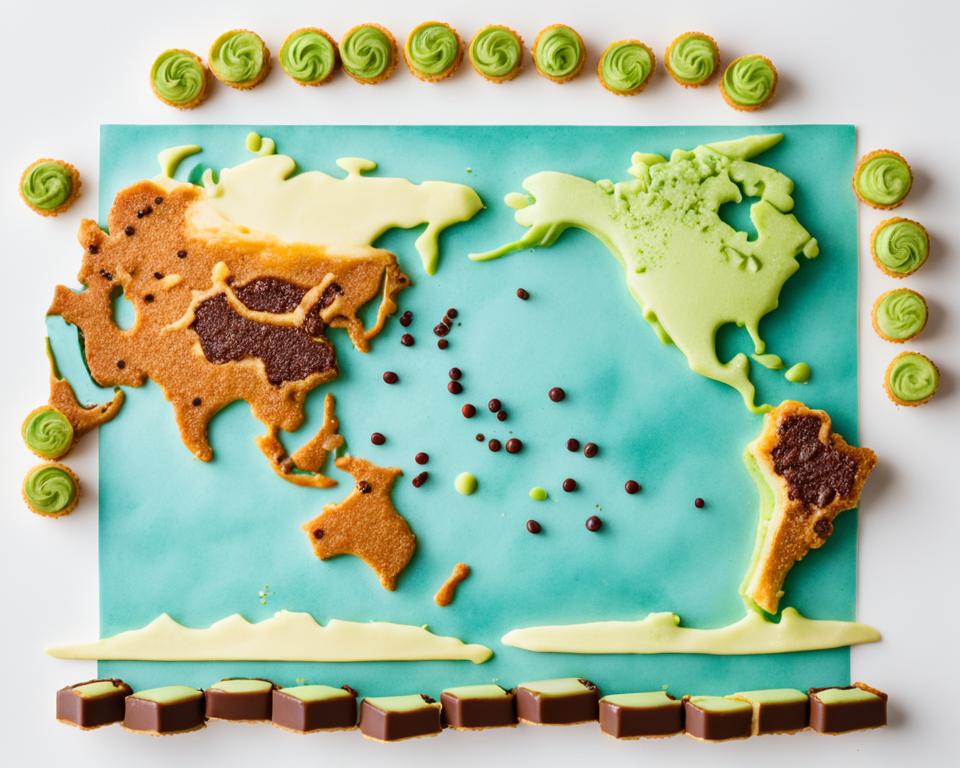
Cultural Interpretations of the Classic Dessert
Around the world, the classic dessert of Napoleon pastry has found itself reinterpreted through the lens of local traditions. In Italy, where “millefoglie” is layered with rich mascarpone cream and topped with berries, the dessert adds a distinctly Italian touch. Head over to Russia, and you encounter “Napoleon torte”, a beloved adaptation often layered with dulce de leche, reflecting Russian preferences for sweet, creamy desserts.
Incorporating Local Ingredients for a Unique Touch
Local ingredients are the keystones that transform the familiar Napoleon into something new and exotic. Bakers have been using seasonal fruits, native spices, and even local dairy products to infuse the flaky pastry with a taste of their home. This approach doesn’t just diversify the Napoleon pastry repertoire; it also enriches the cultural tapestry of desserts, making the Napoleon pastry an international canvas for culinary innovation.
| Region | Local Twist on Napoleon Pastry | Unique Ingredients |
|---|---|---|
| Italy (Millefoglie) | Mascarpone cream layers | Fresh berries, mascarpone cheese |
| Russia (Napoleon torte) | Dulce de leche in place of vanilla pastry cream | Dulce de leche, extra puff pastry layers |
| Latin America | Fruit-filled pastry layers | Tropical fruits like guava or mango |
By incorporating local produce and techniques, the flaky pastry that epitomizes the Napoleon is given a refreshing makeover that can surprise and delight even the most die-hard enthusiasts of the classic dessert. These regional takes reinvent the way we think about this age-old sweet, inviting us to taste the world through its delicate, buttery layers.
Healthier Alternatives: Lightening Up the Flaky Napoleon
For health-conscious foodies and dessert lovers alike, the quest for a lighter flaky Napoleon that retains its essence as a delicious pastry and French dessert is an ongoing adventure. Innovations in recipe formulation have opened up delightful possibilities for creating versions with reduced calories, less sugar, and alternative ingredients, all while maintaining that gourmet experience.
Among the clever substitutions to reduce the overall richness without compromising taste is the integration of lower-fat dairy products. Introducing skim milk or light cream in place of their full-fat counterparts into the pastry cream reduces caloric intake significantly, while still providing a creamy texture that Napoleon aficionados crave. Furthermore, the use of natural sweeteners with a lower glycemic index presents a smarter choice for a delicious sweetness that doesn’t spike blood sugar levels.
Moreover, embracing gluten-free alternatives for the puff pastry not only caters to those with dietary restrictions but can also offer a unique textural twist to the traditional flaky pastry. And let’s not forget, the addition of fresh fruits as a layer not only adds natural sweetness and vibrancy to the Napoleon but also boosts the nutritional profile of the dessert.
| Ingredient Alteration | Benefit |
|---|---|
| Lower-Fat Dairy | Decreased Caloric Content |
| Natural Sweeteners | Reduced Sugar Intake |
| Gluten-Free Puff Pastry | Dietary Inclusion & Unique Texture |
| Fresh Fruit Additions | Natural Sweetness & Health Benefits |
The gastronomic experience of indulging in a flaky Napoleon need not be a guilty pleasure reserved for special occasions. With these adaptations, the beloved French dessert can transform into a wholesome treat that can be savored with much less hesitation. These healthier alternatives provide a delectable path for those looking to enjoy the timeless delicious pastry without foregoing their nutritional preferences or dietary needs.
Fun Facts and Myths About the Napoleon Pastry
The flaky Napoleon, a riveting classic dessert, has a background as layered and intricate as its puff pastry. Over time, a myriad of legends have risen, many enduring despite their lack of historical evidence. One prevalent myth surrounds the dessert’s assumed namesake, Napoleon Bonaparte, leading many to wonder about the veritable origins of this culinary marvel.
Debunking Napoleon Bonaparte Connection Myths
The lore claiming that the Napoleon pastry was named after the famed French emperor is as enticing as the dessert itself. However, historians and pastry chefs assert that there is no documented correlation between Bonaparte and the pastry. In reality, “Napoleon” may be a nod to its French roots, but the confection predates his empire. Known originally as mille-feuille, which means “thousand sheets” in French, the dessert’s appellation may have evolved based on linguistic corruption or playful homage rather than historical patronage.
Fun Anecdotes from Pastry Chefs and Bakers
Pastry chefs and bakers often recount amusing stories and happenstance from behind the scenes of crafting the flaky Napoleon. From mistakenly inverted puff pastry layers that led to unexpectedly delightful textures to fortuitous vanilla bean shortages prompting creative alternatives, the journey of the Napoleon pastry has been a source of both practice and lore in the baking community. Just as each layer of pastry provides dimension, so too do these tales add depth and charm to the tradition of this beloved sweet.
As the fervent preparation of the Napoleon pastry whisks on, so does the interweaving of myths and fact. It’s these very stories—whether apocryphal or anecdotal—that endow the classic dessert with an esprit as delightful as its flaky, cream-laden layers. In each bite, we savor not just the sweetness of the dessert but also the rich impressions of its storied past.
Conclusion
In essence, the flaky Napoleon remains a paragon of pastry excellence, an embodiment of the elegance that typifies a true French dessert. From the meticulous assembly of its fragile, crisp layers to the luxuriant sweep of the vanilla bean pastry cream, each element of this delicious pastry tells a story of culinary artistry and passion. The satisfaction derived from partaking in a slice of Napoleon is akin to experiencing a tapestry of textures and tastes that pay homage to the skill and creativity of its maker.
Whether adhering to tradition or embracing a modern twist, each dessert recipe that has evolved from the classic Napoleon stands as a testament to its versatility. In this journey across time and borders, the beloved Napoleon has truly found its place as a global delight, adapting to the nuances of regional flavors while remaining sincere to the original symphony of flaky indulgence. This storied delicious pastry continues to spark inspiration and affection in the hearts of dessert aficionados and bakers alike.
Conclusively, the flaky Napoleon is more than just a dessert recipe; it is a celebration of heritage and innovation—a creation that transcends the basics of baking to become something that is cherished worldwide. With its layers of grandeur and a fill of creamy splendor, the Napoleon does not merely satiate the palate; it enchants the senses, reaffirming its rightful place as an iconic and esteemed French dessert on the world stage.
FAQ
What is a Flaky Napoleon?
A Flaky Napoleon, also known as mille-feuille, is a classic French dessert consisting of delicate, buttery puff pastry layers filled with rich vanilla bean pastry cream, typically finished with a feathered icing decoration.
Can I use store-bought puff pastry for my Napoleon pastry?
Yes, you can use high-quality store-bought puff pastry for convenience, and it can yield delicious results that closely mimic the flaky layers of homemade pastry.
What are the key ingredients for making a delicious vanilla bean pastry cream?
Premium ingredients for a delicious vanilla bean pastry cream include whole milk, heavy cream, unsalted butter, sugar, eggs, and authentic vanilla beans for a rich flavor and appealing speckled appearance.
What baking tools do I need to prepare a Flaky Napoleon?
Essential baking tools for a Flaky Napoleon include a rolling pin, precise measuring tools, baking sheets, and parchment paper to aid in achieving even thickness and an evenly baked flaky texture.
How do I achieve the ideal consistency for the pastry cream?
To achieve the ideal pastry cream consistency, simmer the milk with a whole vanilla bean, then incorporate the vanilla seeds into the mixture and carefully temper the eggs to avoid curdling, cooking until the cream is thick yet smooth.
How is the distinctive feathered icing on a Napoleon pastry created?
The feathered icing effect is created by drizzling chocolate glaze over white vanilla icing in fine lines and then running a toothpick through the lines perpendicular to the drizzles to create a feather-like pattern.
How can I serve my Napoleon pastry to enhance the taste experience?
To enhance the serving experience, pair the Flaky Napoleon with a cup of coffee, which complements the cream’s richness, or with a sweet dessert wine that harmonizes with the sweet flavors of the dessert.
What are some modern variations of the Flaky Napoleon?
Modern variations of the Flaky Napoleon may include alternative fillings such as chocolate ganache, fruit jams, or even savory spreads, as well as innovative toppings like nuts, toffee bits, or fresh fruit.
What is the best way to store a Flaky Napoleon?
A Flaky Napoleon is best enjoyed fresh but can be refrigerated shortly if covered tightly. Individual components, like the pastry cream and baked puff pastry layers, can be made in advance and stored in the refrigerator or freezer.
How do you prevent the puff pastry layers in a Napoleon from becoming soggy?
To prevent soggy puff pastry layers, bake them until fully golden brown and crisp. If layers soften, briefly reheat them in the oven to restore crunchiness before assembly.
How has the Flaky Napoleon been adapted in different countries?
Bakers worldwide have adapted the classic Flaky Napoleon by incorporating local flavors, seasonal fruits, and regional spices, customizing the dessert to reflect local culinary preferences.
Are there lighter options available for making a Flaky Napoleon?
Yes, for a lighter Flaky Napoleon, you can substitute full-fat dairy with lower-fat alternatives, opt for sweeteners with low glycemic indexes, use gluten-free puff pastry, or include a layer of fresh fruit to account for dietary preferences.
What are some common myths regarding the Flaky Napoleon?
A common myth about the Flaky Napoleon is that it was named after Napoleon Bonaparte. In reality, its name, mille-feuille, which means “thousand leaves” in French, refers to the dessert’s numerous flaky pastry layers.

